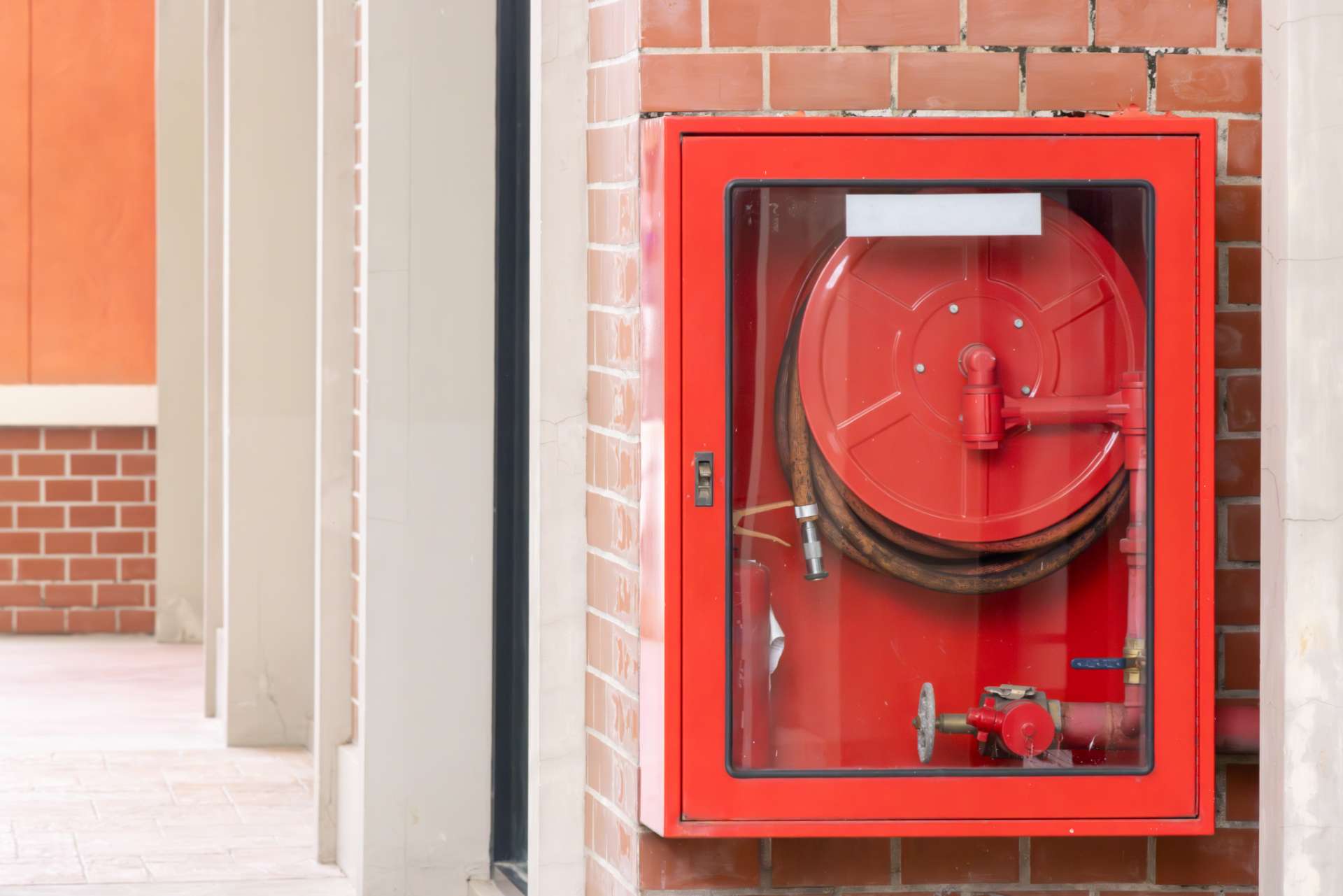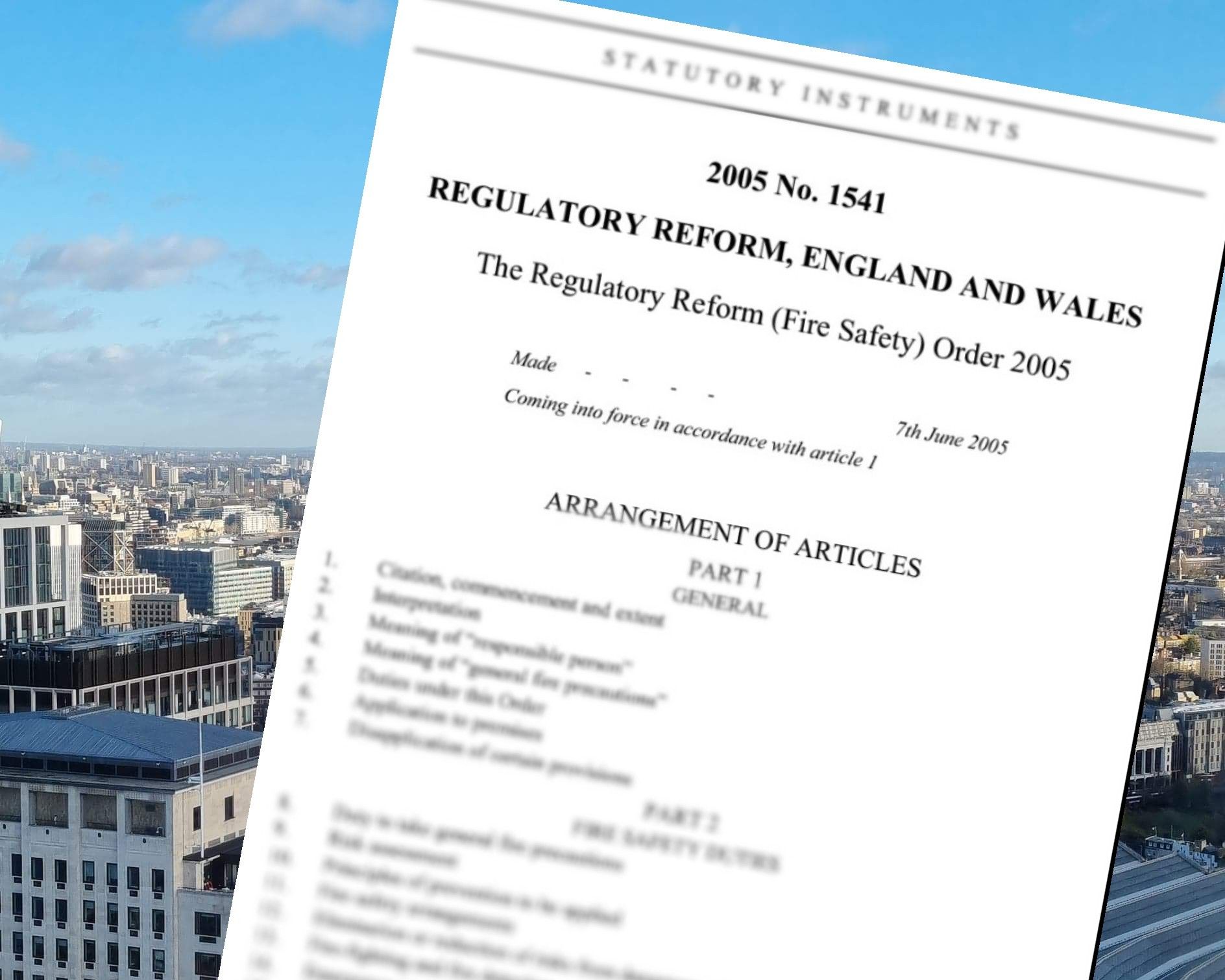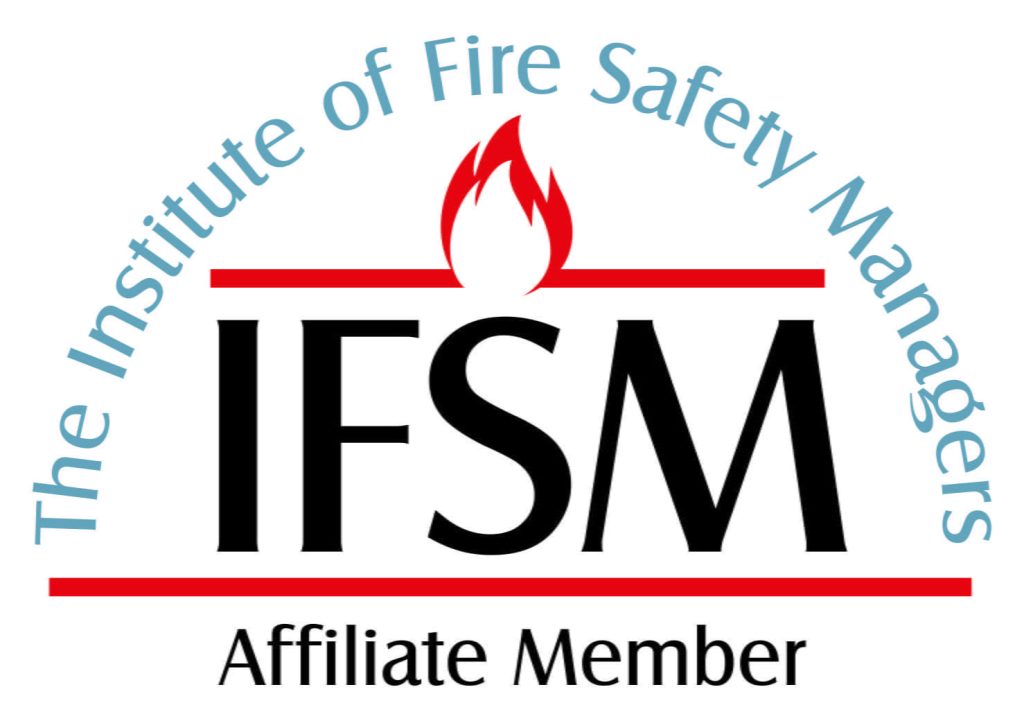
FIRE SAFETY
LEGISLATION
THE REGULATORY REFORM FIRE SAFETY ORDER 2005
ALSO KNOWN AS THE FIRE SAFETY ORDER 2005
THE FIRE SAFETY ACT 2021 AND FIRE SAFETY ENGLAND
REGULATIONS 2022
Fire safety legislation is gathered under The Regulatory Reform (Fire Safety) Order 2005 for England and Wales (RRFSO) and it states a fire risk assessment must be conducted for all commercial premises used for non-domestic purposes including the common parts of multi-occupied residential buildings containing two or more domestic premises and premises with public access. This is fire safety law with a few exceptions.
These fire safety regulations detail who is responsible for completing a fire risk assessment. The regulatory reform order 2005 places legal duties on anyone in control of these premises known as the responsible person. The responsible person is usually the employer – the director or manager of the business as a whole. Or they could be the owner of the premises – this could be either the employer or a landlord. The responsible person must undertake an assessment of the fire risks to people on the premises or within the vicinity – fire risk assessment and put in place and maintain general fire precautions.
In many situations there will be more than one person subject to the obligations of a responsible person for the premises and they must take all reasonable steps to work with each other.
You may be the responsible person if:
You are not the employer but have some degree of control over the premises (where there isn’t a traditional employer/ employee relationship or where volunteers are involved).
You own a commercial premises and it is not legally under someone else’s control, for example it is derelict.
Fire regulations for holiday lets. A fire risk assessment will still need to be conducted for properties that are mainly used by paying guests rather than employees, such as self-catered accommodation or guest houses.
COMPLY with Fire Safety Legislation

SUMMARY OF LEGAL OBLIGATIONS FOR THE RESPONSIBLE PERSON:
Conducting a fire risk assessment is a duty placed directly on the responsible person and to be reviewed regularly. The RRO 2005 states the fire risk assessment must be suitable and sufficient.
Inform staff of all the findings from the fire risk assessment, provide fire safety instruction and training including fire marshals or fire wardens and conduct fire drills.
Equip the premises with appropriate fire safety measures.
Ensuring all fire provisions are maintained to an efficient working order.
Plan for an emergency.
The fire risk assessment must be reviewed regularly and changes made if this is necessary, if there are changes in the processes, personnel or the premises are altered.
How often should a fire risk assessment be reviewed? How often should a fire risk assessment be done? There is no specified time frame within the fire regulatory reform act for the fire risk assessment frequency to repeat assessments or review it. We recommend conducting a fresh assessment every three years or sooner if required based on the nature of the business or premises. The responsible person must review it ‘regularly’ to ensure it remains up to date.
The Fire Safety Act 2005 states every business must appoint one or more competent persons, with exceptions to assist in undertaking the preventive and protective measures. Where the requirement for conducting a fire risk assessment has been delegated, the responsible person continues to carry the burden of responsibility for carrying out that risk assessment.
Under the fire legislation, the responsible person must consider property safety, firefighter safety and the environment around the premises as well as protecting life.
Keep your business, your employees, your customers and your reputation safe by complying with Fire Safety Law and we will conduct an Independent Fire Risk Assessment. For all business sectors and landlords.
COMPLY with Fire Safety Law
NEW FIRE REGULATIONS
THE FIRE SAFETY ACT 2021 COMMENCED 16 MAY 2022
In the case of multi-occupied residential buildings with two or more sets of domestic premises, the Fire Safety Act puts beyond doubt that structure, external walls (including cladding, balconies, doors and windows) and flat entrance doors to individual flats that open into common parts, or any other relevant door fall within the scope of the Fire Safety Order. The Fire Safety Act requires Responsible Persons to ensure that these elements are included in their fire risk assessments, if they have not been covered already.
The act covers the extension of responsibilities on existing responsible persons. Responsible persons must provide relevant fire safety instructions to their residents on how to report a fire and what a resident must do once a fire has started. Responsible persons must provide residents with information relating to the importance of fire doors.
The Regulations also set out requirements for responsible persons of multi-occupied residential buildings of over 11 metres in height to conduct annual and quarterly checks of fire doors. They must undertake best endeavours to carry out annual checks of flat entrance doors. They must undertake quarterly checks of all fire doors in the common parts.
THE FIRE SAFETY (ENGLAND) REGULATIONS 2022
The Regulations for high-rise residential buildings (at least 18m or 7 storeys in height) also require responsible persons to:
Provide their local Fire and Rescue Service with up-to-date building floor plans by electronic means and to place a hard copy of these plans, alongside a single page building plan which identifies key firefighting equipment, in a secure information box on site.
Provide to their local Fire and Rescue Service information about the design and materials of a high-rise building’s external wall system and to inform the FRS of any material changes to these walls. Also, they are required to provide information in relation to the level of risk that the design and materials of the external wall structure gives rise to and any mitigating steps taken.
Responsible for undertaking monthly checks on the operation of lifts intended for use by firefighters, and evacuation lifts in their building and check the fun tionality of other key pieces of firefighting equipment. They are also required to report any defective lifts or equipment to their local Fire and Rescue Service as soon as possible after detection if the fault cannot be fixed within 24 hours, and to record the outcome of checks and make them available to residents.
Install and maintain a secure information box in their building. This box must contain the name and contact details of the responsible person and hard copies of the building floor plans.
Provide wayfinding signage – install signage visible in low light or smoky conditions that identifies flat and floor numbers in the stairwells of relevant buildings.
PUBLICLY AVAILABLE SPECIFICATION (PAS 9980)
The fire risk assessment must include a visual inspection of the external walls of the property. Where the fire risk assessment identifies any cladding or combustible material on the external wall of a property, and the assessor cannot accurately determine the fire risk posed by the materials, they will recommend a more detailed fire risk appraisal of the external walls (FRAEW) is carried out.
An FRAEW assesses the risk to life from external fire spread by the external wall structure; the report will support the building’s fire risk assessment and will allow the building managers to manage the safety of the occupants.
PAS 9980 is a Publicly Available Specification used when conducting an FRAEW assessment. This provides a methodology for a detailed assessment of the external wall construction and cladding for existing multi-occupied residential buildings where an intrusive inspection may be required. Intrusive inspections are only required if there are concerns about the structural fire protection of the building. PAS 9980 emphasises proportionality in relation to fire risk and mitigation measures with considerations of benefit gained, practicality and cost.
THE FIRE SAFETY (EMPLOYEE’S CAPABILITIES) (ENGLAND) REGULATIONS 2010
This business regulation only applies within England and came into force on 6th April 2010. It places a responsibility on employers to consider the capabilities of their employees as regards health and safety when entrusting them with fire safety related tasks.
This clarifies in relation to the Fire Safety Order that the entrusted employee is to have the necessary skills and experience to ensure safety. If they do not have the appropriate skills or experience, training should be carried out in relation to their specific task. Such delegated tasks could be as a nominated fire warden or marshal or carrying out a fire risk assessment or review.
It would be prudent for employers to determine if their delegated employees have the necessary skills and experience to conduct a suitable and sufficient fire risk assessment in order to comply with these statutory regulations.
Fire Risk Assessment near me locations
Bath, Berkshire, Bridgwater, Bristol, Cheltenham, Chippenham, Devon, Exeter, Gloucester, Gloucestershire, London, Maidenhead, Plymouth, Reading, Slough, Somerset, South West, Swindon, Taunton, Weston-super-Mare, Wiltshire, Worcester, Worcestershire, Yeovil
EVERY BUSINESS IN THE UK IS REQUIRED TO CONDUCT A FIRE RISK ASSESSMENT
Find out more and book an assessment with our expert team today to keep your premises and its occupants safe.
© 2024 All Rights Reserved Independent Fire Risk Assessments Ltd | Registered in England and Wales | Company No. 14398880 | VAT Reg No 427037410


